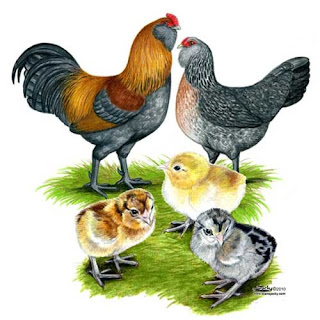About Chicken Breeds...
The Black Jersey Giant Chicken:
This chicken is supersized! The Jersey Giant, as its name implies, was developed in New Jersey and is a true giant of the chicken world. Although created as a dual-purpose fowl (valued for both meat and eggs), it isn't used on commercial farms because it takes 6 months for them to grow to full size, whereas commercial strains can reach their desired size as early as 5 weeks of age. The Jersey Giant is good-natured and hens are decent brown egg layers.

Origins/History:
American
Large Fowl
Very Heavy (8+ lbs)
Rare
Dual
Officially recognized colors: Black and White. Unofficial: Blue, Splash
Egg Facts:
Good (3/wk)
Brown
X-Large
Fancy Features:
Single Comb
No
No
4
Suitability to Backyard Life:
Hardy in winter
Not especially heat hardy
Bears confinement well
Yes
No
Docile and easygoing
The Leghorn Chicken:
Leghorns hail from Italy and, like all Mediterranean chickens, they're slim with large combs and wattles, white earlobes, active, good foragers, and good layers of white eggs. None, however, compare to the White Leghorn (which we've made into a separate listing because their egg qualities are so far superior to any other Leghorn).
Origins/History:
Mediterranean
Large Fowl & Bantam
Medium (6-7 lbs)
Rare
Egg-laying
Dark Brown, Light Brown, White, Black, Buff, Silver, Black-Tailed Red, Columbian, Golden Duckwing
Egg Facts:
Good (3/wk)
White
Large
Fancy Features:
Depends on Variety
No
No
4
Suitability to Backyard Life:
Not cold hardy
Tolerates heat well
Bears confinement well
No
No
Active and intelligent
We will only be getting in the Brown Leghorn in 2019
The Wyandotte Chicken:
Wyandottes are a favorite amongst backyard flock owners for their dependable egg laying, easygoing nature, hardiness, and the great variety of beautiful feather patterns available. Silver Penciled, Golden Laced, Blue, Columbian and White Wyandottes are all rather rare.
 |
| Blue Laced Red Wyandotte hen |
Origins/History:
American
Large Fowl & Bantam
Heavy (7-8 lbs)
Common
Dual
Official: Silver Laced, Golden Laced, White, Black, Buff, Partridge, Silver Penciled, Columbian, Blue. Unofficial: Blue Laced Red, Barred & others.
Egg Facts:
Very Good (4/wk)
Brown
Large
Fancy Features:
Rose Comb
No
No
4
Suitability to Backyard Life:
Hardy in winter
Not especially heat hardy
Bears confinement well
Yes
Yes
Generally easygoing with a tendency toward domination
 |
| Columbian Wyandotte hen |
The Maran Chicken: The chocolate egg layer
 |
| Cuckoo Maran |
Marans are "chocolate eggers" meaning their eggs are a deep chocolate brown color. Eggs of the Black Copper variety--and to a lesser extent, the Silver Cuckoo--are usually the darkest of all, and are highly sought after! If you value a colorful egg basket, Marans are a "must" for your flock! Silver Cuckoo is the most available Marans plumage in North America, although interestingly, that plumage color is not recognized by the APA. Cuckoo Marans in this country are often clean-legged, while others have the standard feathered legs.
 |
| French Black Copper Maran |
Origins/History:
Continental (French)
Large Fowl & Bantam
Heavy (7-8 lbs)
Rare
Egg-laying
APA recognized: White, Wheaten, Black Copper. Not recognized: Birchen, Blue, Salmon, Blue Silver Salmon, Silver Cuckoo, Golden Cuckoo, Others
Egg Facts:
Good (3/wk)
Chocolate
Large
Fancy Features:
Single Comb
No
No
4
Suitability to Backyard Life:
Hardy in winter
Not especially heat hardy
Bears confinement well
No
Yes
Varies
 |
| French Wheaten Maran hen |
The Brabanter Chicken:
The Brabanter breed originated in the historic region of Brabant in the Netherlands. It is a very old breed, the oldest known image of one is in a painting of 1676 by the Dutch artist Melchior d'Hondecoeter. The breed quickly gained popularity, but became nearly extinct around the early 1900's, but were recreated from different German breeds.
Black and Cuckoo Brabanters were shown at the first German poultry exhibition in Saxony, in 1854. A bantam variety of Brabanter was created in around 1934, by cross-breeding the standard-sized Brabanter with bearded bantams of the Polish breed.
This breed is closely related to Owl Beards and has been crossed with them for the breed’s survival in the past. While they are Ornamental they are also bred for their production of white eggs, which they lay fairly regularly. Their eggs can be white white or slightly tinted.
The American Poultry Association has not yet recognized Cream and Gold Brabanters as a Standard Breed of Fowl.
- Breed Purpose:
- Ornamental
- Comb:
- V-Shaped
- Broodiness:
- Seldom
- Climate Tolerance:
- All Climates
- Egg Productivity:
- Medium
- Egg Size:
- Large
- Egg Color:
- White
- Breed Temperament:
- Friendly,Flighty,Bears confinement well,Shy
- Breed Colors/Varieties:
- In the US: Cream and GoldOutside of US: Self-Black, White, Blue-Laced, Cuckoo, Golden Black Half-Moon Spangled, Silver Black Half-Moon Spangled, Yellow White Half-Moon Spangled, Golden Blue Half-Moon Spangled, and Lavender.
- Breed Size:
- Large Fowl
We will only be getting in the Cream Brabanter in 2019.
The Brahma Chicken:
Brahmas are gentle giants with feathered legs and feet and profuse, fluffy feathering. Originally from India, these birds were bred for meat production, though the hens lay relatively decently and are great setters and mothers. This fancy breed of chicken makes a great pet for its quiet and tame nature, tolerance to the cold, huggability and sheer chic-ness!
 |
| Buff Brahma hen |
Origins/History:
Asiatic
Large Fowl & Bantam
Very Heavy (8+ lbs)
Common
Dual
Dark, Light, Buff
Egg Facts:
Good (3/wk)
Brown
Medium
Fancy Features:
Pea Comb
No
Yes
4
Suitability to Backyard Life:
Hardy in winter
Not especially heat hardy
Tolerates confinement
Yes
Yes
Quiet and tame
 |
| Dark Brahma hen |
 |
| Light Brahma hen |



























